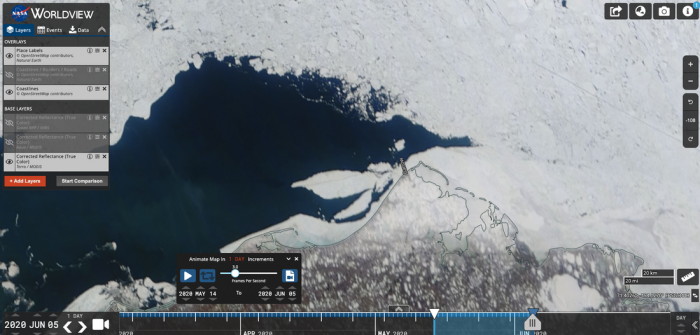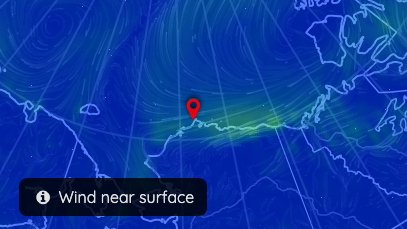Buoys Deployed in Arctic Ocean
A global pandemic could not stop the International Arctic Buoy Program from deploying drifting weather buoys into the Arctic Ocean off the coast of Utqiaġvik, Alaska during these past few months. With the collaborative effort of many partners, buoys were designed, fabricated, shipped, and deployed out on the sea ice before the ice broke away from Utqiaġvik for the summer.
 Saturdays are for Buoys team buoy measures air pressure, surface temperature and GPS positions. Photo from International Arctic Buoy Program
Saturdays are for Buoys team buoy measures air pressure, surface temperature and GPS positions. Photo from International Arctic Buoy Program
My role in this was facilitating the online learning meetings of the Sea Cadet Arctic Buoy Program along with the expertise and leadership of Lieutenant Commander John Woods of the Office of Naval Research, Reserve Component, Dr. Ignatius Rigor of the Polar Science Center at University of Washington, and Cy Keener an Assistant Professor of Sculpture + Emerging Technology at the University of Maryland. Together this team guided the Sea Cadets in the process of learning, designing, and engineering the development of new buoys.
2020 was the first year for the U.S. Naval Sea Cadet Corps to partner with the International Arctic Buoy Program to get 16 and 17 year old Sea Cadets engaged in STEM learning in the Arctic. A group of nearly 20 highly qualified Sea Cadets were selected for the first Sea Cadet Arctic Buoy Program. The primary task of the Sea Cadets was to design and build the environmental sensors that measure weather data, and also design the hull, or buoy, that holds and protects the sensors while out in the elements of the Arctic. They worked remotely from across the country in small teams of 3-4 to accomplish their mission. If we had traveled to the Arctic, two of the Sea Cadets would have accompanied the science team to the Arctic to deploy their buoys in April.
Since early May completing the mission of getting the Sea Cadet's buoys to Utqiaġvik to be deployed by our local collaborators and then watching the data come in has been fun to watch. The drifting buoys were completed, created, and shipped from all over the country to Dr. Rigor in Seattle and then on to Anchorage where they were then taken way north to Utqiaġvik. You can see this travel path on the IABP data map. Experienced Field Specialists (Wilbur Leavitt, Jerry Brower, and Harvard Brown) from the UIC Science in Utqiaġvik took the buoys out on the sea ice via snowmobile and made sure they were turned on and ready to send data through satellite signals.
In this post, enjoy exploring the live data portals, map data visualizations, and the photos from the deployments on the ice.
 Map shows initial buoy deployments. The red lines are trails over the ice created by locals to access open water for whale hunting. Image by Matt Druckenmiller, Craig George, and Joshua Jones, UAF
Map shows initial buoy deployments. The red lines are trails over the ice created by locals to access open water for whale hunting. Image by Matt Druckenmiller, Craig George, and Joshua Jones, UAF
At the time of deployment, there was a large mass of land-fast ice pushed up against the shore near Utqiaġvik. Quickly after they were deployed, the ice began to come apart and drift out to sea (breakup) along with some of the buoys. As of June 4th, Sea Cadet teams buoys Ice-Pelican-004 and APL-IT-0007 were on the move. Arctic Byrds and Wolverines (team buoys) may have started to move early on the 5th. This was and still is a super exciting time where each buoy's fate is unknown. Some buoys could stay lodged on large pieces of ice and travel for weeks or months. Other buoys could end up in open water and flow with the currents. Buoys can also be crushed and become unresponsive as the wind shifts and the ice heads back to shore.
With a bit of detective sleuthing, you can try to follow the fate of your buoy by monitoring the IABP website, and check out realtime daily satellite imagery through NASA's EOSDIS Worldview. You can fast forward and reverse the time of the image with the arrows on the bottom left to see the ice move around. You can also see the latitude/longitude location for anywhere you hover your cursor.
 NASA Worldview Screenshot on June 5, 2020 as ice is breaking away from Utqiaġvik
NASA Worldview Screenshot on June 5, 2020 as ice is breaking away from Utqiaġvik
We are watching the movement and also the data reports to help us understand where they are and the weather and ice/ocean conditions of that location. You can watch the external temperature sensor values on the IABP site to see if they increase during the day and decrease at night (meaning they are probably on ice), or stay constant just below 0 degrees C, meaning they are probably in the ocean.
 June 5, 2020 Buoys drifting north of Utqiaġvik, Alaska. International Arctic Buoy Program map
June 5, 2020 Buoys drifting north of Utqiaġvik, Alaska. International Arctic Buoy Program map
 June 5, 2020 wind speed at Utqiaġvik, Alaska and across the Arctic Ocean. Fluid Earth Viewer
June 5, 2020 wind speed at Utqiaġvik, Alaska and across the Arctic Ocean. Fluid Earth Viewer
2020 Plankowner - Sea Cadet Arctic Buoy Program To Continue in 2021
All who participated in this first year of this new Sea Cadet STEM program received plankowner coins to commemorate their participation in the first commissioning of this new program. The Sea Cadet Arctic Buoy Program is already planning for 2021 with the potential for increasing participation and continued authentic STEM learning and engagement.
 United States Naval Sea Cadet Corps 2020 Arctic Buoy Program coin
United States Naval Sea Cadet Corps 2020 Arctic Buoy Program coin

Add new comment